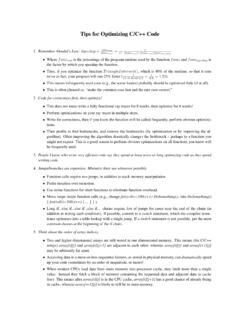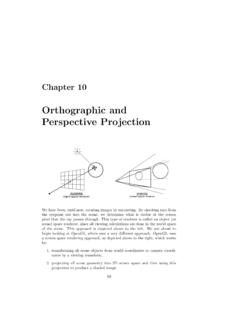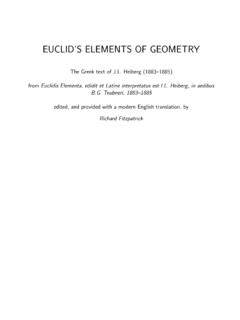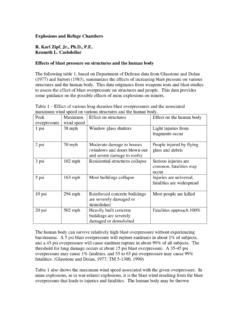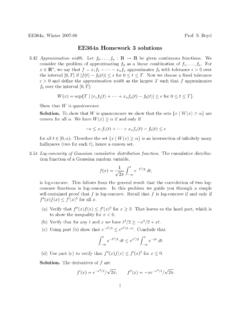Transcription of Vectors - Clemson University
1 A P P E N D I Scaling a Unit or Direction vector vector Points and Parametric definition of lines and Dot or inner Trigonometric interpretation of dot Geometric interpretation of dot Dot product example: The distance from a point to Dot product example: Mirror Cross Trigonometric interpretation of cross Cross product example: Finding surface Cross product example: Computing the area of Foundations of Physically Based Modeling and AnimationTo a mathematician, a vector is the fundamental element of what is known as a vectorspace, supporting the operations of scaling, by elements known as scalars, and alsosupporting addition between Vectors .
2 When using Vectors to describe physical quantities,like velocity, acceleration, and force, we can move away from this abstract definition, andstick with a more concrete notion. We can view them as arrows in space, of a particularlength and denoting a particular direction, and we can think of the corresponding scalarsas simply the real numbers. Practically speaking, a vector is simply a way of simultaneouslystoring and handling two pieces of information: a direction in space, and a magnitude arrow is a convenient way to draw a vector ; since both length anddirection are clearly indicated. A real number is a convenient wayto represent a scalar, which when multiplied by a vector changesits length.
3 To the left are three visual representations of identicalvectors. They are identical, since they are all of the same length andthe same direction, they are parallel to each other. Their locationwithin the space is the study of physically based animation, we will initially be interested in Vectors in two-dimensional (2D) and in three-dimensional (3D) space, whose elements are real , we will see later that Vectors can be defined in a space of any number of dimensions,with elements that may themselves be , a vector is usually denoted by a lower-case letter, which has a line over it,likev, or is printed in bold type, likev. For hand written notes, the line is most convenient,but in printed form the bold form is more usual.
4 Throughout these notes the vector in 2D Euclidean space is defined by a pair of scalars arrangedin a column, likev=[vxvy].Examining the diagram to the right, we see thatvxdenotes thehorizontal extent orcomponentof the vector , andvyits verticalcomponent. Note, that in a computer program this structure can beeasily represented as a two-element array of floating point numbers,or a struct containing two floats. When working in 2D, the directionof the vector can be given by the slopem=vy/vx. Its magnitude,also called itsnorm, is written v . By the Pythagorean Theorem, v = v2x+ vector in 3D space is defined by three scalars arranged in a column,v= vxvyvz ,wherevxis the horizontal component,vythe vertical component, andvzthe depthVectors 321component.
5 The norm of a 3D vectorvis v = v2x+v2y+ 3D there is no simple equivalent to the slope. The direction of a 3D vector is often givenin terms of its azimuth and elevation. But, for our purposes it will be best understood by itscorresponding unit vector , which we will describe after first defining some key algebraicvector SCALING A VECTORa2aa/2 Multiplication of a vector by a real number scalar leaves thevector s direction unchanged, but multiplies its magnitude bythe scalar. Algebraically, we multiply each term of the vectorby the scalar. For example2a=2[axay]=[2ax2ay].Division by a scalar is the same as multiplication by the recip-rocal of the scalar:a/2=[ax/2ay/2].
6 UNIT OR DIRECTION VECTORSa The direction of a vector is most easily described by aunit vector , alsocalled adirection vector . A unit vector , for a particular vector , is parallelto that vector but of unit length. Therefore, it retains the direction, butnot the norm of the parent vector . Throughout these notes the notation vwill be used to indicate a unit vector in the direction of parent vectorv. For example, the unit or direction vector corresponding with the 2 Dvectorawould be a=[ax/ a ay/ a ]=[ ax ay].322 Foundations of Physically Based Modeling and vector ADDITIONaa+bbAddition of Vectors can be expressed by a diagram. Placing thevectors end to end, the vector from the start of the first vector tothe end of the second vector is the sum of the Vectors .
7 One wayto think of this is that we start at the beginning of the first vector ,travel along that vector to its end, and then travel from the startof the second vector to its end. An arrow constructed between thestarting and ending points defines a new vector , which is the sumof the original Vectors . Algebraically, this is equivalent to addingcorresponding terms of the two Vectors :a+b=[axay]+[bxby]=[ax+bxay+by].W e can think of this as again making a trip from the start of the first vector to the end ofthe second vector , but this time traveling first horizontally the distanceax+bxand thenvertically the distanceay+ vector SUBTRACTIONbaa - bSubtraction of Vectors can be shown in diagram form by placing thestarting points of the two Vectors together, and then constructing anarrow from the head of the second vector in the subtraction to thehead of the first vector .
8 Algebraically, we subtract correspondingterms:a b=[axay] [bxby]=[ax bxay by]. POINTS AND Vectors (0,0)(x,y)YpOpXThis leads us to the idea that points and Vectors can be inter-changed almost. While Vectors can exist anywhere in space,a point is always defined relative to the origin,O. Thus, we cansay that a point,p=(x,y), is defined by the origin,O=(0,0)and a vector ,p=[xy], + the origin is assumed to be the point(0,0), points andvectors can be represented the same way, the point(2,3)can be represented as thevector[23]. This interchangeability can be very convenient in many cases, but can also leadVectors 323to confusion. It is a good idea to make sure that when storing data, you clearly indicatewhich values are points, and which are Vectors .
9 As will be seen below, the homogeneouscoordinates used to define transformations can help with to the above, we can write,p=p O, a vector defines the measure fromthe origin to a particular point in space. More generally, a vector can always be definedby the difference between any two points,pandq. The vectorv=p qrepresents thedirection and distance from pointqto pointp. Conversely, the pointqand the vectorvdefine the point,p=q+v, which is translated fromqby the components PARAMETRIC DEFINITION OF LINES AND RAYSp x(t)tThis leads us to a compact definition of a line in space,written in terms of a unit vector and a point. Letpbe aknown point (expressed in vector form) on the line beingdefined, and let abe a unit vector whose direction is par-allel to the desired line .
10 Then, the locus of points on theline is the set of all pointsx, satisfyingx(t)=p+t variabletis a real number, and is known as the lineparameter. It measures the distance from the pointptothe pointx(t). Iftis positive, the pointxlies in the direction of the unit vector from pointp, and if t is negative, the point lies in the direction opposite to the unit definition of a ray is identical to the definition of a line , except that the parametertof a ray is limited to the positive real numbers. Thus, a ray can be interpreted as startingfrom the pointp, and traveling in the direction of aa distance corresponding tot, astgoes from0to increasingly large positive values. On a ray, the pointpis called the rayorigin, athe ray direction, andtthe distance along the DOT OR INNER PRODUCTV ector- vector multiplication is not as easily defined as addition, subtraction and scalarmultiplication.

